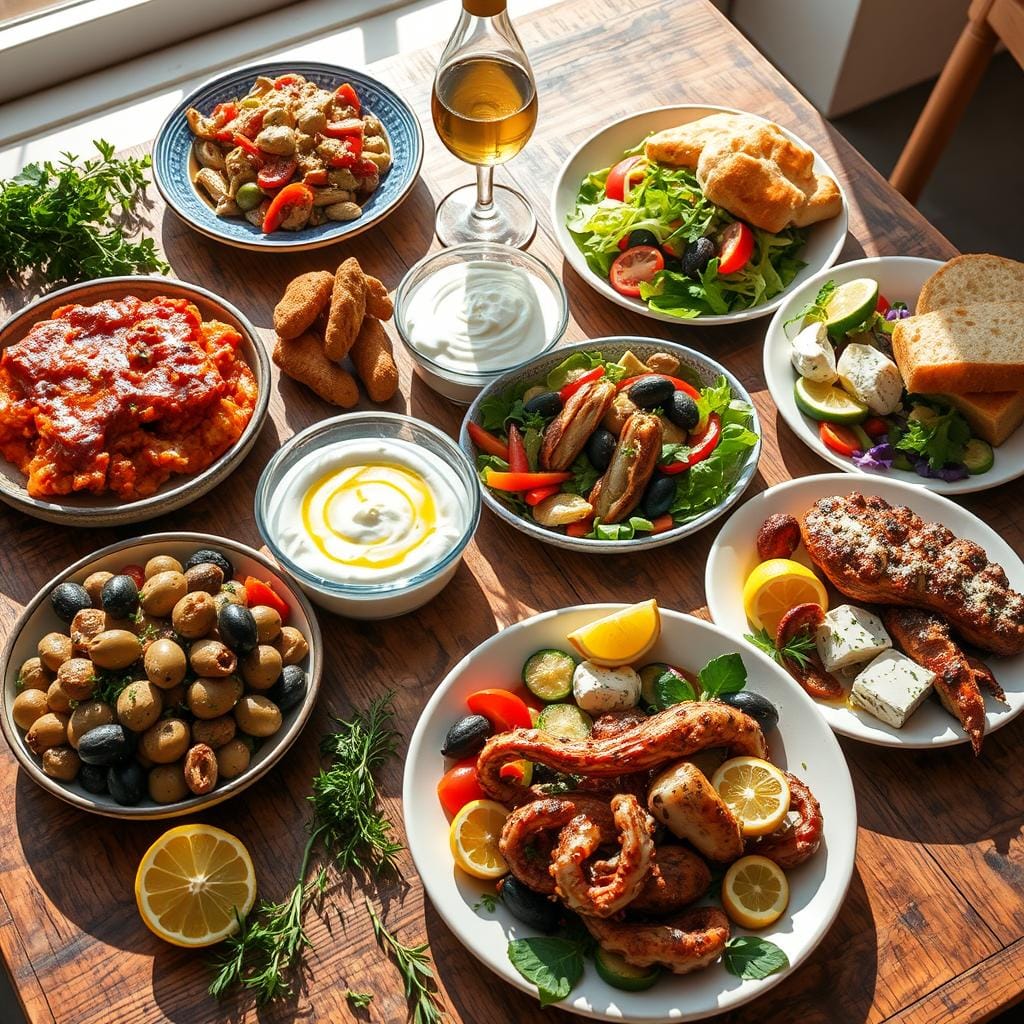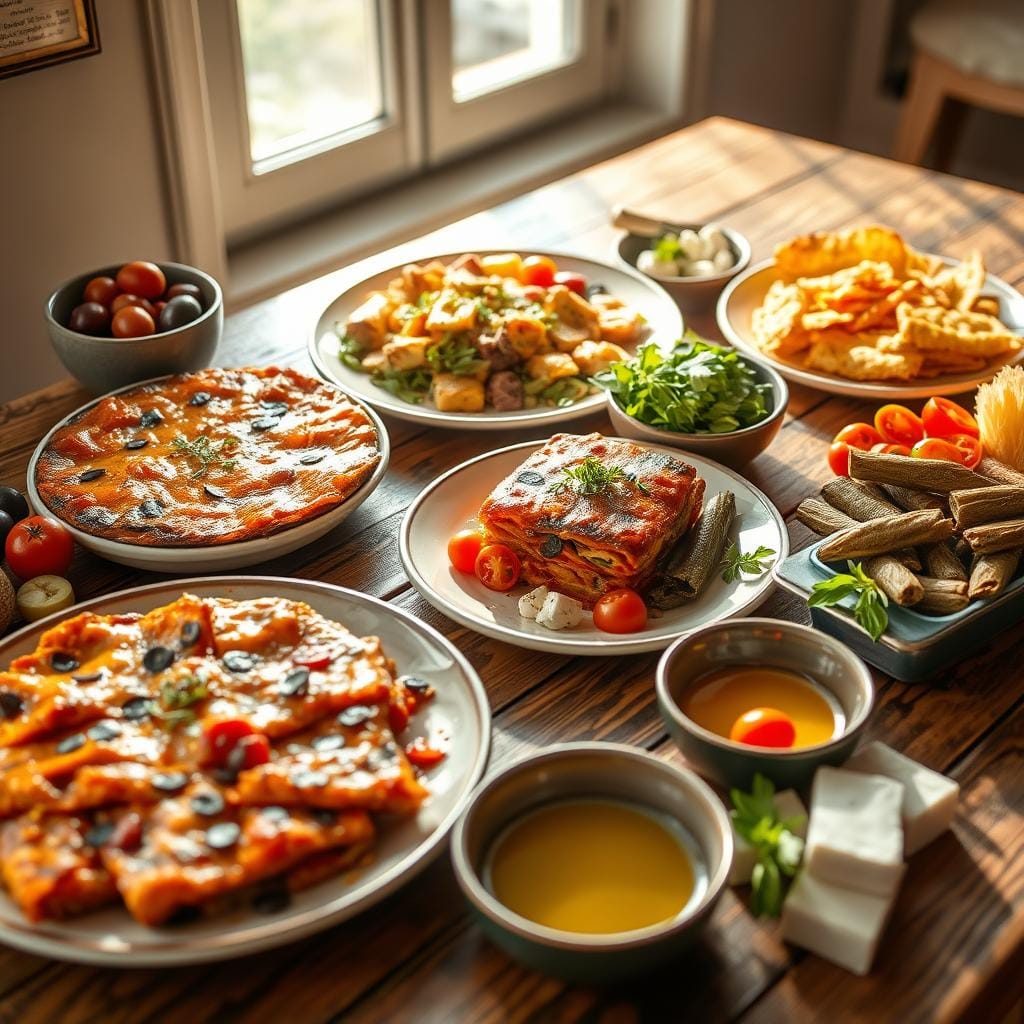As I walked through Athens, the smell of sizzling meats and fresh bread filled the air. It invited me to dive into Greece’s rich food culture. From lively markets to cozy tavernas, Greece’s food has won the hearts of many. Let’s discover the traditional Greek dishes that are key to the Mediterranean diet.

Key Takeaways
- Greece’s cuisine is deeply rooted in the Mediterranean diet, blending local ingredients with centuries-old culinary traditions.
- Iconic Greek dishes, from appetizers to desserts, showcase the country’s diverse regional flavors and cultural influences.
- Exploring traditional Greek dishes provides a window into the nation’s rich history, hospitality, and enduring love for food.
- The Mediterranean diet, which includes many traditional Greek dishes, is recognized for its health benefits and sustainable approach to eating.
- This guide will introduce you to the must-try traditional Greek dishes that have made the country’s cuisine a global favorite.
Understanding the Rich Heritage of Greek Cuisine
Greek cuisine has a long history, shaped by many influences over the years. At its core is the Mediterranean diet. This diet focuses on fresh, seasonal foods and celebrates local specialties.
The Mediterranean Diet Influence
The Mediterranean diet is key to Greek food culture. It’s rich in fruits, vegetables, whole grains, and legumes. It also includes olive oil and some dairy, poultry, and seafood. Traditional Greek dishes reflect this balanced eating style.
Historical Evolution of Greek Food
Greek cuisine has evolved over time, influenced by many cultures. From ancient Minoans to the Byzantine and Ottoman periods, each era added its own touch. These influences have blended into the rich culinary heritage of Greece.
Regional Culinary Variations
Greece’s diverse regions showcase different culinary traditions. The Aegean islands and the mainland have their own flavors and dishes. This variety highlights the richness of Greek cuisine.
| Region | Signature Dishes | Key Ingredients |
|---|---|---|
| Crete | Dakos, Chochlioi boubouristi, Apaki | Olive oil, barley rusks, snails, cured meats |
| Peloponnese | Giouvetsi, Moussaka, Laconian stew | Tomatoes, eggplant, lamb, orzo pasta |
| Macedonia | Bougatsa, Pites, Soutzoukakia | Phyllo pastry, ground meat, spices |
Exploring Greek cuisine’s heritage reveals its deep connection to the Mediterranean diet and its history. It also shows the variety of flavors across different regions. This understanding enriches our appreciation of Hellenic culinary traditions.

What Are The Traditional Greek Dishes?
Dive into the rich tapestry of authentic Greek recipes and explore the iconic Greek meals that have shaped the country’s culinary landscape for generations. From savory classic Greek fare to tantalizing regional specialties, the traditional dishes of Greece offer a mouthwatering journey through the nation’s vibrant food culture.
Start with the beloved moussaka, a layered casserole with eggplant, ground meat, and creamy béchamel sauce. This comforting dish is a staple in Greek homes and loved worldwide.
No visit to Greece is complete without trying souvlaki. It’s skewers of marinated and grilled meat, served with pita bread, tzatziki sauce, and fresh veggies. This iconic Greek meal is a beloved street food and a quintessential part of the country’s culinary heritage.
| Authentic Greek Recipes | Iconic Greek Meals | Classic Greek Fare |
|---|---|---|
| Moussaka | Souvlaki | Dolmades |
| Spanakopita | Giouvetsi | Gemista |
| Dolmades | Pastitsio | Fasolada |
Alongside these beloved authentic Greek recipes, the country’s culinary traditions also include other mouthwatering dishes. These include the savory dolmades (stuffed grape leaves), the flaky spanakopita (spinach and feta pie), and the hearty giouvetsi (baked meat and orzo casserole).
“Discovering the diverse and flavorful world of traditional Greek dishes is a true delight for any food enthusiast.”
Whether you’re seeking comforting classic Greek fare or exploring the vibrant iconic Greek meals that have captivated taste buds worldwide, the traditional dishes of Greece offer a delicious and immersive cultural experience.

Essential Greek Appetizers and Mezedes
Dive into the world of Greek mezedes, the small plates that are key to Greek food. These appetizers make Greek meals and gatherings unforgettable. They show off the variety of flavors and textures found in traditional Greek appetizers.
Popular Dips and Spreads
Iconic Greek dips like creamy tzatziki, rich taramasalata, and smoky melitzanosalata (eggplant dip) are essential. They’re often served with warm pita, crisp veggies, and other small dishes. This mix creates a perfect balance of tastes and textures.
Hot and Cold Starter Dishes
- Dolmades: Grape leaves stuffed with a savory rice and herb filling.
- Spanakopita: Flaky phyllo dough filled with spinach, feta, and herbs.
- Keftedes: Tender meatballs, often seasoned with mint and served with a tangy sauce.
- Kolokythokeftedes: Crispy zucchini fritters, a delightful vegetarian option.
Traditional Greek Salads
No Greek meal is complete without a traditional Greek salad. The classic horiatiki (village salad) with juicy tomatoes and tangy feta is a must-try. The vibrant dakos with rusks, tomatoes, and olives is another favorite. These salads offer a refreshing start to any meal.
“Mezedes are not just food, they are a way of life in Greece. They bring people together, spur conversation, and connect us to our rich cultural heritage.”
Iconic Greek Main Courses
Dive into the heart of Greek cuisine with its iconic main courses. Discover the beloved moussaka and the ever-popular souvlaki. These authentic Greek recipes have won the world’s culinary heart. Enjoy the robust flavors and comforting textures that make classic Greek fare a favorite worldwide.
Moussaka is a standout traditional Greek dish. It’s a layered casserole with tender eggplant, ground lamb or beef, and a rich béchamel sauce. Pastitsio is another classic, a baked pasta dish with macaroni, ground meat, and a creamy topping. Both are comfort food at its finest.
| Iconic Greek Main Dish | Key Ingredients | Defining Characteristics |
|---|---|---|
| Moussaka | Eggplant, ground meat, béchamel sauce | Layered casserole with robust flavors |
| Pastitsio | Macaroni, ground meat, creamy topping | Baked pasta dish with comforting textures |
| Souvlaki | Skewered and grilled meat, pita bread, tzatziki sauce | Grilled meat skewers served with pita and creamy sauce |
| Gyros | Spit-roasted meat, pita bread, tzatziki sauce | Spit-roasted meat served in a pita with creamy sauce |
Souvlaki and gyros are also beloved. Souvlaki offers skewered and grilled meat with fluffy pita and tzatziki sauce. Gyros features spit-roasted meat in a pita with tangy tzatziki. These traditional Greek dishes have become favorites around the world, showcasing Greece’s rich culinary heritage.
“Greek cuisine is a delicious celebration of the Mediterranean’s bounty, where simple ingredients are transformed into mouthwatering masterpieces.”
Classic Greek Seafood Specialties
Greece’s coastal areas are famous for their seafood dishes. These dishes come from the Aegean and Ionian seas. You’ll find grilled octopus and calamari on the islands and local specialties that highlight the sea’s unique flavors.
Fresh Fish Preparations
The Greeks are experts at making simple yet tasty fish dishes. Grilled whole fish is a classic, seasoned with lemon, olive oil, and herbs. This lets the fish’s natural flavors come through. Fried fish, like small whitebait, is also popular. And baked or poached fish often come with tomatoes, olives, and capers.
Shellfish and Ocean Delicacies
The Greeks love unique sea creatures too. Grilled or sautéed octopus is a favorite, marinated in vinegar or wine. Calamari, whether fried, grilled, or stuffed, is a seafood favorite. And mussels, clams, and shrimp are common in Greek seafood dishes.
| Greek Seafood Dish | Description |
|---|---|
| Grilled Octopus | Tender octopus, marinated and grilled to perfection, often served with a tangy vinegar or wine sauce. |
| Fried Calamari | Crispy, golden-brown rings of calamari, a beloved meze (appetizer) in Greece. |
| Baked Whole Fish | Fresh, whole fish, often seasoned with lemon, olive oil, and herbs, baked to flaky perfection. |
Enjoying the fresh catch or unique sea flavors, Greek seafood dishes show Greece’s deep sea connection and culinary traditions.
Traditional Greek Meat Dishes
Dive into the rich and savory world of Greek meat dishes. Here, centuries-old culinary traditions come to life. From the slow-cooked elegance of lamb kleftiko to the hearty comfort of stifado stews, Greek cuisine offers a wide range of authentic meat preparations. These dishes reflect both pastoral heritage and festive celebrations.
Kleftiko is a quintessential Greek meat dish. It comes from the Klephts, Greek guerilla fighters during the Ottoman occupation. This tender lamb is marinated in herbs and lemon, then slow-roasted. It creates a symphony of flavors that dance on the palate.
| Traditional Greek Meat Dish | Key Ingredients | Cooking Method |
|---|---|---|
| Kleftiko | Lamb, lemon, herbs | Slow-roasted |
| Stifado | Beef or rabbit, onions, red wine | Slow-braised |
| Giouvetsi | Beef or lamb, kritharaki (orzo) | Oven-baked |
Stifado is another beloved traditional Greek meat dish. It’s a hearty stew made with beef or rabbit. Slow-braised in a rich sauce of onions, red wine, and spices, stifado offers a comforting and satisfying culinary experience.
Explore the diverse and flavorful world of Greek meat recipes. Discover the true essence of this Mediterranean culinary heritage.
Authentic Greek Pastries and Desserts
Explore the sweet side of Greek cuisine. Discover iconic Greek desserts like baklava and galaktoboureko. These treats showcase the rich heritage and regional flavors of traditional Greek sweets.
Sweet Phyllo Creations
Phyllo pastry is key in authentic Greek pastries. Baklava, with its flaky layers and honey, is a beloved treat. Galaktoboureko, filled with custard, also highlights phyllo’s versatility.
Traditional Holiday Sweets
Greek celebrations bring out special Greek desserts. Try kourambiedes, buttery cookies with powdered sugar, during holidays. Kourabiedes, scented with almonds, are also a festive favorite.
Regional Dessert Specialties
Greece’s regions offer unique traditional Greek sweets. In the Peloponnese, enjoy rose-infused loukoumades. The Ionian Islands are known for walnut diples.
From Macedonia’s creamy rice pudding to Thessaloniki’s sweet cheese bougatsa, Greece’s pastry traditions are a feast for the senses.
| Traditional Greek Dessert | Key Ingredients | Unique Characteristics |
|---|---|---|
| Baklava | Phyllo dough, nuts, honey, cinnamon | Flaky, rich, and sweet |
| Galaktoboureko | Phyllo dough, custard, lemon, butter | Creamy, delicate, and citrusy |
| Loukoumades | Fried dough, honey, cinnamon, rose water | Fluffy, fragrant, and indulgent |
“The sweetness of Greek pastries is not just a delight for the palate, but a celebration of the country’s culinary heritage and the joy of sharing.”
Greek Street Food Favorites
Discover the lively world of Greek street food. Here, old flavors meet new cooking ideas. Enjoy favorites like souvlaki and gyros, and try unique local dishes. These quick, tasty foods show Greece’s rich culinary heritage and changing food culture.
Step into the lively Greek street food world. Find a wide range of authentic Greek snacks and traditional Greek fast food. Try the smoky meats in soft pita bread or the creamy tzatziki yogurt dip.
- Souvlaki: Skewered and grilled meat, often served in a pita with vegetables and sauces.
- Gyros: Slices of seasoned meat, typically lamb or pork, stacked on a vertical rotisserie and shaved onto a pita.
- Tiropita: Flaky phyllo pastry filled with a blend of tangy cheeses.
- Spanakopita: Savory spinach and feta-filled phyllo triangles.
Exploring Greek street food, you’ll find special dishes from different areas. Try the famous bougatsa custard pastry from Thessaloniki or the tasty koulouri sesame bread rings from Athens. These traditional Greek snacks give a peek into Greece’s food history.
Looking for a fast meal or a true taste of Greek culture? The lively Greek street food scene will excite you. It shows the traditional Greek fast food that wins hearts of both locals and visitors.
“The secret to great Greek street food lies in the perfect balance of flavors and the quality of the ingredients. It’s a true reflection of the country’s rich culinary traditions.”
| Popular Greek Street Food | Description |
|---|---|
| Souvlaki | Skewered and grilled meat, often served in a pita with vegetables and sauces. |
| Gyros | Slices of seasoned meat, typically lamb or pork, stacked on a vertical rotisserie and shaved onto a pita. |
| Tiropita | Flaky phyllo pastry filled with a blend of tangy cheeses. |
| Spanakopita | Savory spinach and feta-filled phyllo triangles. |
Conclusion
Your journey through traditional Greek dishes has been enlightening. You’ve learned about the Mediterranean diet and how Greek cuisine evolved. You now appreciate the complexity and uniqueness of Greek food.
The iconic appetizers, main courses, and desserts have shown Greek cuisine’s versatility and cultural importance. These dishes not only taste great but also connect us to Greece’s history and vibrant culture.
Enjoying these Greek recipes, you see their lasting appeal to food lovers everywhere. Whether you try a hearty Greek dish or dive into the Mediterranean diet, you’ll be amazed. Greek cuisine is a powerful way to unite people, celebrate culture, and nourish both body and soul.
FAQ
What are the most iconic and traditional Greek dishes?
Traditional Greek dishes include moussaka, a layered eggplant and ground meat casserole. Souvlaki, grilled meat skewers, is also popular. Dolmades, stuffed grape leaves, and spanakopita, spinach and feta filled phyllo pastry, are favorites too. Tzatziki, a yogurt-based cucumber dip, rounds out the list.
How has Greek cuisine evolved over time?
Greek cuisine has a rich history. It’s influenced by the Mediterranean, trade routes, and cultural exchanges. Over time, it has kept its focus on fresh ingredients and traditional cooking methods.
Are there significant regional variations in Greek cuisine?
Yes, Greece’s diverse geography and climate lead to different regional dishes. The islands are famous for seafood, while the mainland has more meat-based recipes. Northern Greece offers heartier dishes, and the south is known for Mediterranean flavors.
What are some of the staple ingredients in traditional Greek cooking?
Olive oil, feta cheese, and yogurt are key in Greek cooking. Grains, legumes, and fresh herbs are also important. The Mediterranean diet’s principles of simplicity and local foods guide Greek cuisine.
How do Greek appetizers and mezedes set the tone for a meal?
Appetizers and small plates, or mezedes, are crucial in Greek dining. Tzatziki, taramasalata, dolmades, and spanakopita not only prepare the palate but also foster socializing. They lead to the enjoyment of main courses and desserts.
What are some of the most iconic Greek main dishes?
Iconic Greek dishes include moussaka and pastitsio, a pasta dish with ground meat and béchamel sauce. Souvlaki, grilled meat skewers, is also a favorite. Gemista, stuffed vegetables, and seafood like grilled octopus and fish stew are beloved too.
Can you describe some traditional Greek desserts and pastries?
Greek desserts use honey, nuts, and phyllo dough. Baklava, a layered pastry with nuts and syrup, is famous. Galaktoboureko, diples, and halva are also beloved sweets.
What are some popular Greek street food and fast food items?
Greek street food favorites include souvlaki and gyros, spit-roasted meat in pita. Spanakopita and tiropites, cheese-filled phyllo pastries, are also popular. These dishes reflect Greece’s culinary heritage.


